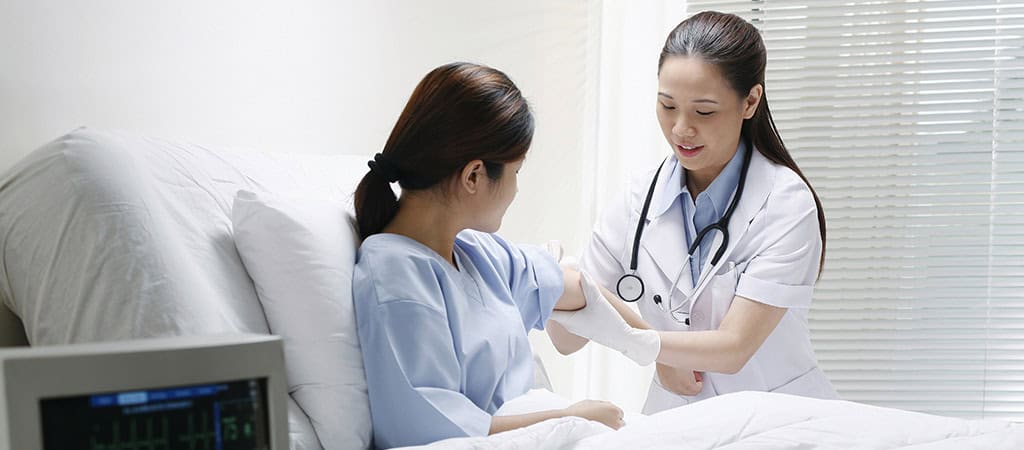
Healthcare-associated infections claim the lives of 1,500 Swedes every year - and many of these deaths could be prevented if healthcare mattresses were kept clean. We explain why and give 5 tips that could save lives.
How bacteria get into the healthcare mattress
In healthcare, covers with polyurethane coatings, often called PU covers, are used. These are designed to keep blood, urine and
other body fluids away from pillows and mattresses, but polyurethane has its limitations.
The combination of body fluids and fats can cause hydrolysis, a chemical process in which molecules break down and begin to release fluid.
The protective layer of the hygiene mattress is also vulnerable to certain cleaning liquids such as chlorine and window cleaner. A single wash can permanently destroy the protective layer.
Polyurethane also does not prevent liquid from entering through seams, zippers, scratches or tears.
All these processes lead to bacteria, like the Greeks at the siege of Troy, managing to take unnoticed
past a supposedly impenetrable defence. The phenomenon is known as "strikethrough", and it has been shown that bacteria can survive up to 206 days in the mattress [1].
If the bacterial host is not detected, every patient using the healthcare bed is at risk of VRI infection.
Where do the bacteria come from?
What is the real risk of a hygiene mattress being exposed to bacteria-contaminated liquid? Let's break down what a mattress is likely to come into contact with over the course of a day.
- Bleeding wounds
- Nosebleeds
- Sweat
- Tears
- Saliv
- Vomiting
- Diarrhoea
- Urine leakage
- Hot water
- Cracked or leaking abscesses
Add to this the spillage of other liquids associated with the meals the patient takes in bed, and the changing of sheets. Each time this happens, the mattress is further exposed to the bacteria.
How are Sweden's hygiene mattresses doing?
There are no national statistics on mattress hygiene in healthcare, but in 2017-2018 a comprehensive mattress inventory was carried out at a medium-sized Swedish county council. All mattresses at the county council's three hospitals were examined using a procedure that assessed the surface layer for damage, discolouration or signs of contamination.
The mattress itself was assessed for age, wear, comfort and contamination levels.
The overall assessment gave one out of three possible ratings:
Green Good condition, functional and hygienic.
Yellow Clean but in deteriorated condition. Should be replaced in the future.
Red Contaminated. Must be replaced immediately.
The results were alarming. Out of 724 mattresses inventoried, only 318 were approved; less than half. 115 mattresses were considered to be in such poor condition that they had to be replaced immediately.
In the period 2016-2018, a similar, county-wide inspection was carried out which included 2 046 beds.
Here, 36% of the mattresses were found to have damaged surfaces. 28% of them also had visible stains.
As healthcare rules, practices and budgets are comparable from county to county, this report gives a clear indication of the extent of the mattress problem at a national level.
The pictures below show what it too often looks like when inspecting the foam core of a mattress.
VRI victim hires "mattress lawyers"
The danger of contaminated mattresses is also felt beyond Sweden's borders. The internationally renowned ECRI Institute, which has been conducting research on medical innovation and development since 1968, published a report in 2018 entitled "Top 10 Health Technology Hazards for 2018".
In third place among these health hazards were contaminated mattresses [2].
In the UK and US, a legal market has emerged around the problem of poor mattress hygiene. Patients suffering from healthcare associated infections can simply choose to hire one of the "mattress lawyers" who specialise in such lawsuits.
It is a market that should not have to exist.
1. CORRECT PROCEDURES FOR HYGIENE MATTRESSES
Introduce regular inspections in each health care facility, preferably at the time of each patient change.
Examine the hygiene mattress cover for visible signs of damage. Look for tears, scratches, cracks, holes and stains. Then remove the cover and look for moisture, stains and signs of wear or damage to the mattress. Inspect all sides, including the underside
2. PROPER CLEANING
Find out which tools and cleaning agents can be used without risk of damaging the protective layer of the hygiene mattress, and make sure that everyone involved is informed of the rules.
3. THE RIGHT MATERIAL
A good hygiene mattress should have a minimum of seams and zippers as they are risk zones for contamination. It should also have the right type of surface texture. Many of us instinctively feel that a smooth surface should be easier to keep clean, but the evidence says the opposite. Professor Martin Exner, director of the Institute for Hygiene and Public Health at the University of Bonn, has shown that a slightly rippled surface is optimal from a hygiene point of view. The explanation is a "wrinkle effect" that ensures that 73 % more disinfectant lingers during cleaning and thus has time to work properly.
4. RIGHT COLOUR
In 2013, the US FDA issued a warning to opt out of dark mattress covers in favour of light ones. Studies have shown that dark covers have a higher concentration of bacteria than light covers after the same length of use.
This is probably because the human eye finds it more difficult to detect colour changes, stains and other signs of contamination when the cover is dark. Nevertheless, dark coatings dominate in Sweden today. This trend needs to be broken. In theory, a transparent cover would be the optimal option.
5. THE RIGHT ACTIONS
Remove any damaged, worn or visibly stained hygiene mattress. Handle it in accordance with local regulations. It should not be given away, either within Sweden or to aid activities abroad, as it can cause VRI wherever it is used.
These new control and disposal procedures require more time and resources - but sooner or later they will save lives. Against this backdrop, it is literally vital to start striving for better mattress hygiene today.
Source list
[1] Journal of Applied Microbiology, Volume 99 Sept 2005.
[2] ECRI Institute 2017. Executive brief: Top 10 Health Technology Hazards for 2018.






